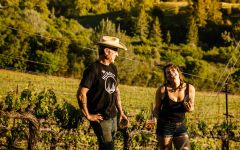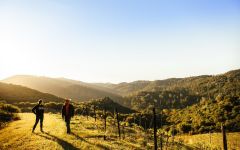Forlorn Hope San Hercurmer delle Frecce Barbera 2016

Product Details
Your Rating
Somm Note
Winemaker Notes
Bright red + black fruit with a range of depth showing cacao and tobacco. Resinous pine, marjoram, tarragon, black cherry juice on the nose. Truly stunning wine that will age for a decade or more.
The 2016 San Hercurmer delle Frecce was grown on the Rorick estate vineyard in Calaveras County, on soils comprised of a layer of schist over dolomite-rich limestone. Elevation of the vineyard is 2000’.






These bottles, the first produced by Matthew Rorick Wines, were our headlong rush into the breach. Rare creatures from appellations unknown and varieties uncommon, these wines are our brave advance party, our pride and joy – our Forlorn Hope.
Matthew Rorick found his passion for food and wine at his grandfather's table, where the elder Rorick's love of sharing a bottle, a meal, and good conversation inspired his career in winemaking.
After receiving his degree in Viticulture and Enology from UC Davis, Matthew worked on a diverse number of winemaking projects including collaborations with wineries in New Zealand, South Africa, and Chile, as well as with Peter Michael Winery, Chasseur, and Miura Vineyards in California, among others. The broad array of different winemaking and grape growing techniques and philosophies he encountered provided a unique practical counterpoint to the theory he learned at University and flavor his current direction in the winery.
Taking his cues from the stones and soil, he endeavors to interrupt the natural development of each of his wines as little as possible in order that the character and uniqueness of each vineyard site may take center stage.

Friendly and approachable, Barbera produces wines in a wide range of styles, from youthful, fresh and fruity to serious, structured and age-worthy. Piedmont is the most famous source of Barbera; those from Asti and Alba garner the most praise. Barbera actually can adapt to many climates and enjoys success in some New World regions. Somm Secret—In the past it wasn’t common or even accepted to age Barbera in oak but today both styles—oaked and unoaked—abound and in fact most Piedmontese producers today produce both styles.

As the lower part of the greater Sierra Foothills appellation, Amador is roughly a plateau whose vineyards grow at 1,200 to 2,000 feet in elevation. It is 100 miles east of both San Francisco and Napa Valley. Most of its wineries are in the oak-studded rolling hillsides of Shenandoah Valley or east in Fiddletown, where elevations are slightly higher.
The Sierra Foothills growing area was among the largest wine producers in the state during the gold rush of the late 1800s. The local wine industry enjoyed great success until just after the turn of the century when fortune-seekers moved elsewhere and its population diminished. With Prohibition, winemaking was totally abandoned, along with its vineyards. But some of these, especially Zinfandel, still remain and are the treasure chest of the Sierra Foothills as we know them.
Most Amador vines are planted in volcanic soils derived primarily from sandy clay loam and decomposed granite. Summer days are hot but nighttime temperatures typically drop 30 degrees and the humidity is low, making this an ideal environment for grape growing. Because there is adequate rain throughout the year and even snow in the winter, dry farming is possible.
